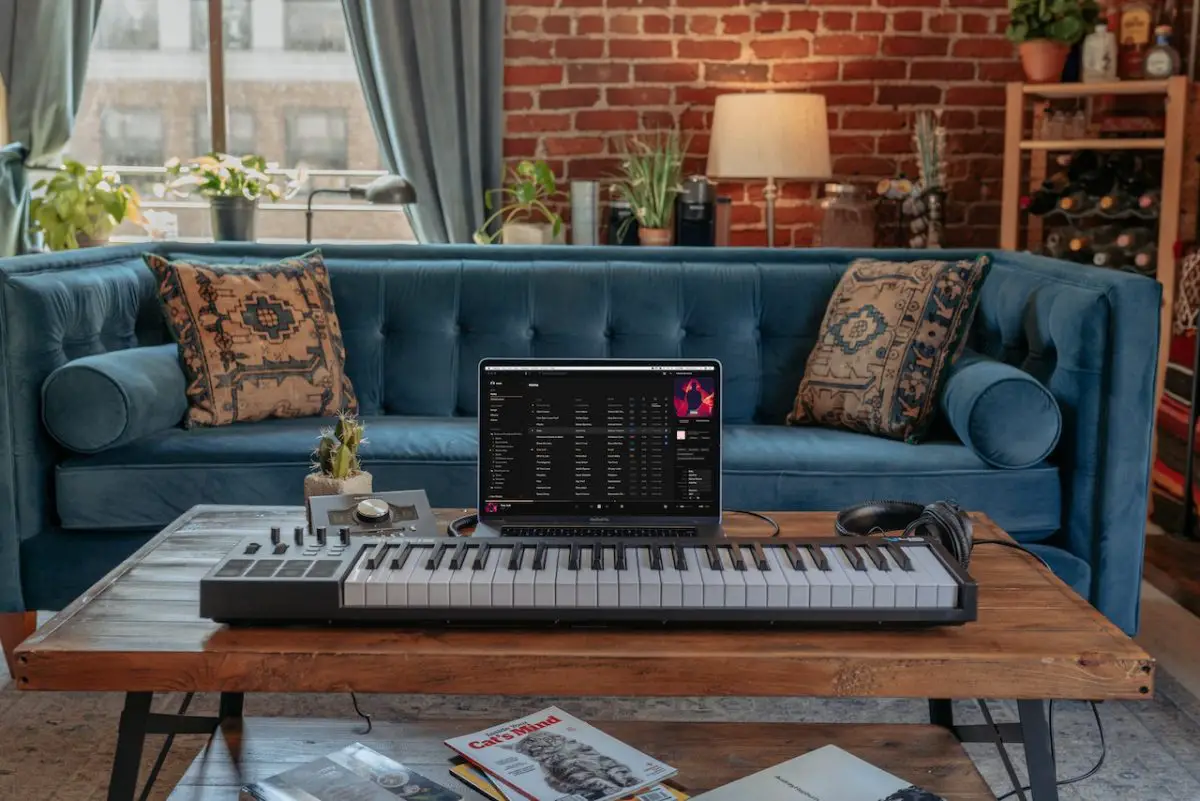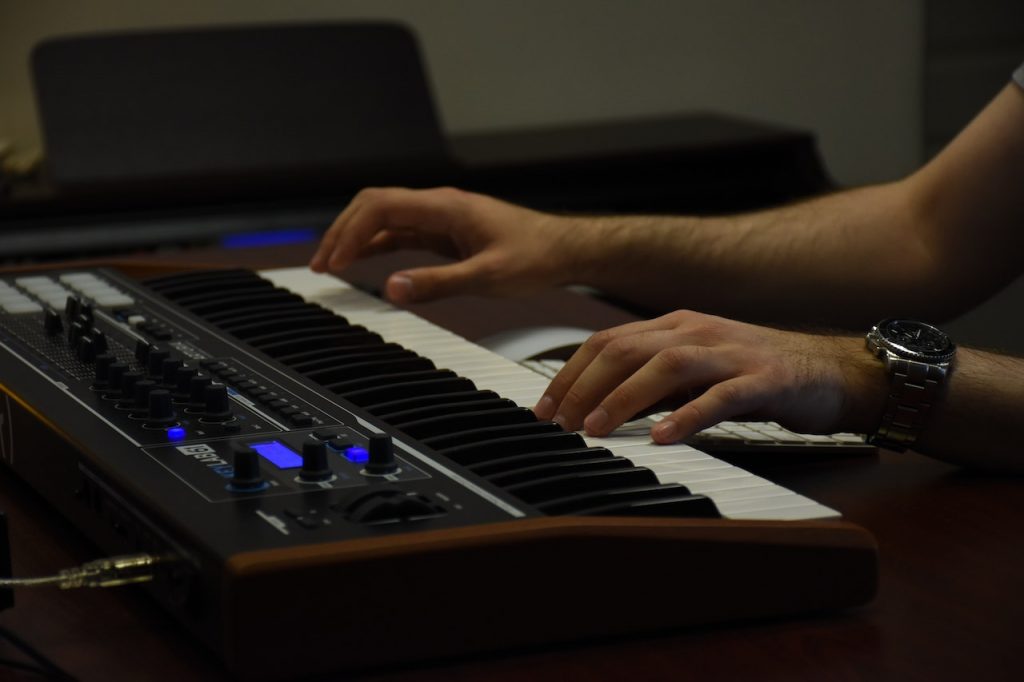If you’re looking to start recording music at home, you’ll need a MIDI controller. But which one is right for you? And how many keys should it have? In this post, I’ll answer these questions and more so that you can decide which MIDI controller is right for you. I’ll also provide tips on picking the perfect one for your needs based on your budget and the type of music you want to record. So if you’re into recording or playing music, this post is for you!
How many keys should a MIDI controller have? The 49-key layout is popular among musicians since it’s easy to use two hands simultaneously. Consider not only the genre of music you’re making but also the size of your home and available space. A smaller keyboard, with only 25 or 32 keys, may be more convenient if you’re always on the go.
What is a midi keyboard?
A MIDI keyboard or controller keyboard is often a piano-style electronic musical keyboard, frequently with additional buttons, wheels, and sliders, that is used to deliver MIDI signals or orders to other musical instruments or computers through a USB or MIDI 5-pin connector.

The most crucial fact to remember about a controller keyboard is that it does not produce any audible effects. So if you get one, you will be disappointed if you think it will work like a regular keyboard or synthesizer. As we said at the beginning, they send MIDI data to other devices to play their sounds.
there’s a MIDI keyboard for everyone who wants to create their own electronic, hip-hop, or classical masterpiece
The number of keys on a controller keyboard may range from 25 to 88. In addition, keyboards may have a completely weighted setting for more advanced hammer action. Finally, there’s a MIDI keyboard for everyone who wants to create their own electronic, hip-hop, or classical masterpiece.
MIDI keyboards have keys and other controls for your DAW and devices. MIDI controller keyboards usually have knobs and sliders that can be set to change a wide range of settings. Many have drum or sample pads that can be played with the fingers and used to trigger samples for playback or recording.
AKAI Professional MPK Mini MK3

AKAI Professional MPK Mini MK3
What are the different size options for MIDI keyboards?
There are numerous key number alternatives available from a variety of brands. They include ones with as few as 25 keys. Which, believe me, feels quite a bit. All the way up to 88-key beasts the size of a full-size piano.
Thus, in addition to the two I just described, the most popular MIDI keyboard categories are as follows: 25 key, 32 key, 49 key, 61 key, and 88 key.
How many keys should a MIDI keyboard have?
There isn’t a single, definitive answer. A compact keyboard may be more practical if you’re starting and your studio space is already at a premium. Octave shifters are often seen on MIDI keyboards. These let you easily go up or down an octave, making them very helpful on keyboards with fewer keys.
So if you’re short on studio space but want to record with a complete MIDI instrument’s frequency range, an octave control MIDI keyboard could be the way to go. If you’re interested in developing your piano skills, this will open up a world of possibilities. I’d put aside a little more cash, clear a bit more room, and get a keyboard with at least 61 keys.
If money is no object, consider buying two. For writing those piano sections, you’ll need a full-sized, 88-key weighted keyboard; for everything else, you’ll need a smaller, semi-weighted keyboard.

How to choose the MIDI keyboard size
Space is obviously a major factor. Getting the biggest keyboard is good if your home recording studio is large. Sadly, though, this is a privilege not enjoyed by everyone. When starting with your home recording studio, providing space for additional gear, such as hardware synthesizers, keyboards, amps, and other parts, is a good idea.
You want to avoid regretting how much desk space you gave up for that MIDI keyboard. Bringing a big keyboard to a party when there is already a lot of gear may be a mistake. But if it’s staying put in the studio, that’s not a problem. How big a keyboard you can afford will depend on your budget.
The dimensions of each keyboard are shown here to provide a starting point for comparison shopping. Remember that not all keyboards include equally sized keys since some smaller models may not have true “piano-sized” keys. This is only approximate, but it should serve as a guide.
| Keys | Keyboard width |
|---|---|
| 25 Keys | 12.5 inches (31.7cm) |
| 32 Keys | 17 inches (43.7cm) |
| 49 Keys | 32 inches (81cm) |
| 61 Keys | 39.5 inches (100cm) |
| 88 Keys | 58.5 inches (145cm) |
Choose the number of keys on your MIDI keyboard based on how good you want to be. You should also choose the number of keys on your MIDI keyboard based on how good you want to be. But if you are or want to become a world-class pianist, It’s recommended that at least 49 keys be present on any piano you use for composition.
With a bigger keyboard, you could assign drums to one end and a synth sound to the other if you consider including it in your live set. Due to the additional functions packed into some of the smaller keyboards, their price might be higher.
It is not easy to choose this one piece of equipment. The best way to pick up a MIDI controller is by asking yourself, What are my goals? Do I plan on performing gigs or just composing songs at home? Do I have limited funds or big ones? Such questions can help you narrow your options and pick the perfect tool.
If you want even more tips and insights, watch this video called “The BEST Midi Keyboards For Music Production in 2021 | Finding the RIGHT Midi Controller For You” from the Edward Smith YouTube channel.
Frequently asked questions (FAQ)
Do you still have questions? Below are some of the most commonly asked questions about how many keys a MIDI controller should have.
Is 25 key MIDI controller enough?
The 25-key keyboard is ideal for taking on the road with you. This is helpful even if you can’t play the piano or keyboard like a pro. However, MIDI keyboards feature smaller keys to fit more octaves into a given footprint.
Unless you have very tiny hands, I wouldn’t recommend these. The risk of making mistakes and going crazy increases when you rapidly play chords or a series of notes.
Can all keyboards be used for MIDI?
All you need is a MIDI OUT port on your keyboard to utilize it as a MIDI controller.
Are 61 or 88 keys better?
Five octaves are all a piano with 61 keys can offer, which is only sometimes enough for certain pieces. Musicians may need to transpose and adapt the score to play it on their chosen instrument.
Should I get a 49 or 61-key MIDI controller?
Whether you opt for a piano with 49 or 61 keys depends on your intended use; for example, if you plan to take a piano course or play “proper” piano and keyboard music with chordal bass, you’ll need 61 keys.
On the other hand, with a score of 49, you should be fine if you plan on playing mostly monophonic synth bass and lead parts.
Conclusion
So, do you have all the keys you need to use a MIDI controller? And did I cover everything you wanted to know? Let me know in the comments section below (I read and reply to every comment). If you found this article helpful, check out my full blog for more tips and tricks on music production. Thanks for reading, and never stop making music.
This article covered what a MIDI keyboard is, the different size options for a MIDI keyboard, and how many keys a MIDI keyboard should have. Here are some key takeaways:
Key takeaways
- Keyboards for MIDI instruments can have anywhere from 25 to 88 keys.
- A compact keyboard may be more practical if you’re studio space is already at a premium.
- If you’re a DJ, you’ll love the portability of a 25-key controller while tweaking the filters on your laptop’s loop sequencer.
- If you have a controller that has both a pitch wheel and a modulation wheel, you can use them to create pitch bend and modulation effects in real time.
- Keyboards with regular-sized keys make it simple to perform chords and melodies.
- The piano-like feel of a keyboard can be enhanced with features like velocity- and aftertouch-sensitive keys and hammer action.
So, do you have all the keys you need to use a MIDI controller? And did I cover everything you wanted to know? Let me know in the comments section below (I read and reply to every comment). If you found this article helpful, check out my full blog for more tips and tricks on music production. Thanks for reading, and never stop making music.















